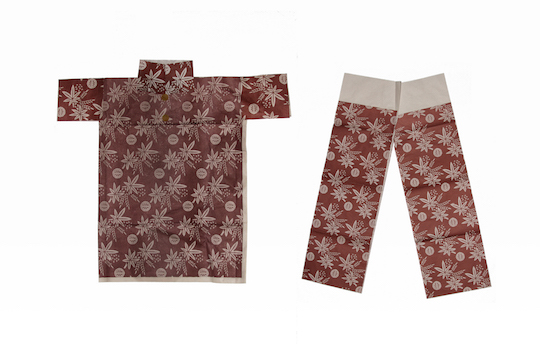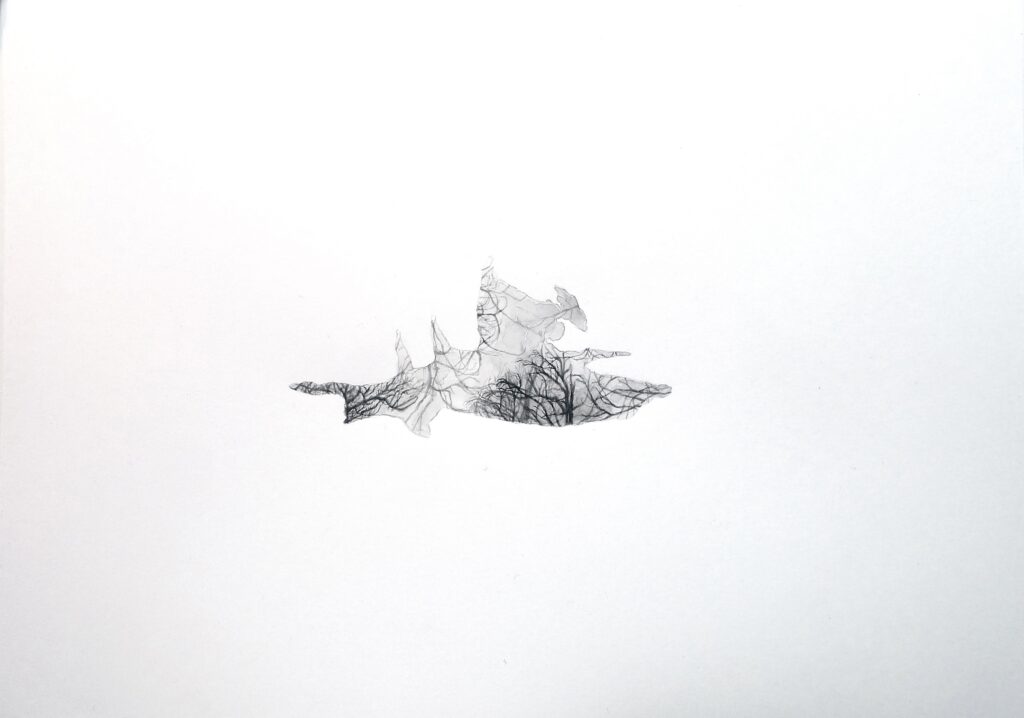Every nonhuman living thing is held captive by our actions.

This piece is part of the Climate notebook, which features art by Katrina Bello.
The human body is an animal body.
My human body is an animal body that has fled from the wild.
I think about this as I sit, enveloped in the temperate climate of an air-conditioned building, and scroll through a list of active wildfires in my home state of California. Each fire is marked on a map with an identical icon of little red flames. During fire season, from late spring until the rains come in winter, the air is unpredictable. Clear days are punctuated with the smell of something burning. Haze fills the valley where I live. And then, again unexpectedly, the wind will change direction and it will be nothing but blue sky and the scent of flowers. Smoke travels, as they say.
My human body is an animal body that was not built to withstand persistent smoke in the air and the heat that is predicted to descend around me in the years to come.
My human body is an animal body that was not built to survive what may become the endpoint of the climate crisis.
Most of the time, I have lived my life as though this isn’t the case. Over the span of decades, I have become insulated by a cocoon of technologies that have the peculiar effect of persuading me that I am nearly invincible, or at least that I am invincible today. Particulate-filled air is sieved through a HEPA filter before it trickles into the building as something more sterile. During one historic drought, and then another, and then yet another, water still spills from the faucet, and sprinkler systems send it cascading across golf courses. Subsidence from an overdrawn underground aquifer seems abstract. The ground under my feet is solid enough. Stories about lost crops from unpredictable frost or excessive heat or the same cycle of drought seem removed to a great distance as I wander through the produce section of the grocery store choosing tomatoes in winter, avocados out of season, fruit in abundance, all lit with the glow of fluorescent lights and misted at regular intervals.
My human body moves through a world that pretends I am not an animal.
My short story collection, What We Fed to the Manticore, is narrated entirely by animals. It began innocuously enough, in my dentist’s office while I waited for Novocaine to take effect.
To pass the time, I flipped through a copy of National Geographic and came across a story called “The Cold Patrol.” The piece described what it was like to live as a member of the Sirius Sled Patrol, a division of the Danish Royal Navy, patrolling Northeast Greenland National Park by dogsled. For the humans on patrol, it’s a life marked by work and survival, set in a landscape of beautiful desolation.
Normally when I read a story like this, I become absorbed by imagining myself in the place of the subject of the article. It’s a way to try on other lives and experiences that are normally beyond my reach. But as I sat in that chair, waiting for numbness to spread across my face, I found myself almost entirely uninterested in the experiences of the two men in the sledge patrol. Instead, I could not stop thinking about the dogs. What did they think of this life? What did the landscape mean to them? What did the two men mean to them, if anything at all? What did it feel like to pull the sledge?
A few weeks later I was walking into work, and as I stepped over train tracks and onto the sidewalk, I was overtaken by an image of a sled dog who is awed by the world around him and tormented by the idea that it contains a whale who is following him under the ice. I started to write from his perspective, guided by a question that has since lodged itself permanently in my mind: In stories that include a whole spectrum of life, but are presented primarily as human stories, what do all of these other creatures think about these events and experiences? What do they think about us and the world that we are continually reshaping around them? And what does it say about us when we choose to shift their experiences to the margins of a story, or out of the picture entirely?
I wrote that one story from an animal perspective without considering if I would write any others, but I was drawn in by feeling that I had climbed out of my own skin and was writing about things that scared me. I wrote about loneliness and insecurity. Fear and beauty. I took everything that I felt unable to say and translated it through the voice of a sled dog. It felt liberating and more honest than anything I had written before. So, I wrote a story about a tiger trying to cling to her moral center while she struggled to survive. And then another about a grieving wolf searching for her brother.
I wanted to remind myself that I am an integral part of the natural world even while I exist in a society that persists in creating systems that separate me from other living things. I don’t know if animals share the same spectrum of emotions as humans. But I hope that they do, and I wonder all the time what they think of the world they share with us. And I wonder how they perceive what we as a species have done to change, shape, and destroy parts of it. I write as a way to imagine myself toward an answer. To create work oriented toward understanding how nonhuman creatures see the world is to deliberately resist the creeping notion that we are separate from nature, and thus safe from its destruction. Art is uniquely qualified to do this because it appeals to the heart more than the mind.
In 2016, I bought a copy of The Great Derangement (University of Chicago Press, 2016) by Amitav Ghosh and devoured it. Ghosh argues that the climate crisis is too absent from contemporary literature and that when a large portion of literary work ignores it, it conceals the urgency of the current climate reality. He carries this thread through an examination of history and politics and finally closes with his hope that writers coming after him will open their eyes, “rediscover their kinship with other beings,” and infuse this renewed understanding into their art.
I understood, objectively, that this book was for everyone to read. And yet, I felt as though it had been written as a specific directive to me. It was as though I had been given permission to write from animal points of view, and what’s more, that I must write this way.
Early in The Great Derangement, Ghosh notes that more and more often, climate change and its impacts are described as “uncanny.” Catastrophic floods, devastating cyclones, massive wildfires—all events with impacts exacerbated by the overall warming of the planet caused by human behavior—are seen as strange, freakish. Today, over six years after The Great Derangement was published, climate-related catastrophic events are still described as “unprecedented” and treated as wholly unexpected, even though more occur every year.
Ghosh analyzes this way of thinking through several angles. But what influenced me the most was Ghosh’s point that by believing that climate-related disasters are uncanny or strange, we are compelled to “recognize something we had turned away from: that is to say, the presence and proximity of nonhuman interactions.” And once we remember we are surrounded by and share space with other living things, we perceive things we may have previously ignored or thought of as part of an inanimate landscape that was merely there to be acted upon by us. The uncanny, the terrifying, the unpredictable, and the strange force us to acknowledge that we are not alone. Once we pay more careful attention to nonhuman life, once we think about it, does it not follow that all the other creatures might think about us? And if they do, what exactly is it that they think?
A year or two after I read The Great Derangement, the valley where I live filled with smoke and drifting ash from nearby wildfires. One weekend afternoon, my husband and I drove to the gym, a decision that carried its own uncanniness in that the air outside was so unsafe to breathe that we transported ourselves from one indoor space to another so we could exercise. As we drove through the parking lot, we passed a long and low wrought iron fence. A red-tailed hawk perched on the midpoint of the fence, and, as our car cruised slowly past, the hawk and I watched each other, both of our heads turning to follow the other with our gaze. The hawk was enveloped in a haze, and the smoke was thick enough that I could still smell the nauseating char inside the car. I wondered what it felt like to the hawk to be in this choked air. And I wondered what the hawk thought of us: these fragile, mostly hairless creatures, scuttling from indoor space to indoor space, mostly escaping the smoke, and continuing on with all of the things that will keep this wheel of climate crisis turning.
To focus on the nonhuman, I had to acknowledge that my perception and experience of the world is incomplete and not necessarily how other creatures receive information. Ed Yong addresses this issue head on in his recent book, An Immense World: How Animal Senses Reveal the Hidden Realms Around Us (Random House, 2022), when he explains the idea of an Umwelt, first introduced in the twentieth-century work of German biologist Jakob Von Uexküll. The Umwelt is a contained category of information that a creature is able to take in via their sense organs in order to perceive the world around it. Yong also emphasizes that an animal existing in the same space as a human may not take in all of the same information, and even if they did, it may mean something entirely different to the animal than it does to us.
Yong is one of many science and nature writers whose work I relied on when researching my stories. I admire how he translates the essential technical data of natural science into an experiential narrative for a layperson like me so that when I read about a natural phenomenon, it is almost as though I understood what it feels like for the animals when the events of the piece are happening. When writing about the ability of a blue whale to slow its heartbeat to only two beats per minute, Yong structured his piece so that each paragraph would mark the time between heartbeats if reading at an average pace. So while reading about the size of whale hearts, the methods for studying them, and the mechanics of a whale’s aortic arch, I felt the rhythm of its heart in the very text I was reading. It was remarkable. Remarkable because instead of a list of sterile facts that my eyes would have eventually skimmed past, I measured the beat of a heart I imagined to be my own. In that piece, it wasn’t possible for me to see myself as fully separate from a blue whale, which was essential for me to maintain empathy for the whale. And from empathy comes care.
What, then, does it mean to write about human impacts on the environment from a nonhuman perspective, when the perceptions and priorities of humans are pushed out of the frame? For me, it meant writing stories where the outcomes of human activity become inescapable for every other living thing. These outcomes—a warming Arctic, intensified storms, the long reach of war, poaching—all permeate the air. They cross continents and touch lives that are otherwise far out of reach of human hands.
It is a position of tremendous power to be a human. As a species, we are constantly remaking ecosystems. We raze mountains, flood valleys, and redirect rivers. We reshape coastlines and build walls to hold back the sea. The extinction of entire species has been accelerated because of human behavior. Across continents, we have remade the landscape to serve ourselves, all while remaining blind to the fact that we are part of the landscape, and its destruction is our destruction. And yet, as Ghosh writes, “we have always been watched by other eyes.”
I will pause here to note that on every continent and in every country, there are communities, indigenous and non-indigenous, who maintain ways of living that are more integrated into the environment, rather than in persistent opposition to it. And that a number of wealthier, more developed countries are responsible for creating and perpetuating the circumstances that led to the climate crisis and that cause it to continue intensifying. As Ghosh and other writers note, both capitalism and imperialism act as significant drivers of the climate crisis and their influence dominates much of our modern life.
In writing from the vantage point of those other watching eyes, I am seeking to close the gap between the narrow way we perceive ourselves, and the way I imagine nonhuman life perceives us. I believe that all living things have the capacity for rich and complex inner lives, and for deep feelings of their own. Both Ghosh and Yong acknowledge this possibility. In Ghosh’s case, by noting the long history of global storytelling traditions containing nonhuman characters that drive and shape narratives. And in Yong’s case, by writing thoughtfully and thoroughly about animal theories of mind, communication, and even culture.
In imagining inner lives for my narrators in What We Fed to the Manticore, I relied on science journalism from Yong and others whose portrayal of what we know about the sensory lives of animals could help me build a picture of perception, and from that I developed my best approximation of meaning. If nonhuman animals can take in a wide and varied amount of sensory data, it must mean something. And because humanity has such a significant impact on ecosystems, it seems impossible to me that every animal would ignore us to the degree that we seem to be able to ignore them. Casual disregard of the ecosystem and its inhabitants is the privilege of an animal who does not believe itself to be an animal. Humans can temporarily flee indoors, ship food over long distances, and pretend that the climate crisis will not impact our way of living. But every nonhuman living thing is held captive by our actions. So, how do we appear in their eyes? Whatever I have imagined is ultimately an imperfect mirror. As Yong writes, “[l]anguage, for us, is both a blessing and a curse. It gives us tools for describing another animal’s Umwelt even as it insinuates our sensory world in its descriptions.”
I don’t know, then, if I have been able to telegraph an approximation of the animal mind in my stories. Maybe I have made a hybrid. A nonhuman vantage point filtered through human perception. And perhaps that is enough. Enough to inspire empathy. Enough to remind us all that we are not as different from our animal brethren as we imagine. Enough to show that we are collectively suffering under the weight of the destruction that our own hands have wrought. That someday we will not be able to filter out the damage and escape to a sanctuary indoors. Enough to remind us that our human bodies are animal bodies.



